Africa is home to more than 2,500 different bird species. African birds are available in a virtually unlimited variety of sizes, forms, and colors, ranging from tiny, vividly colored sunbirds and tenacious little bee-eaters to ominous marabou storks.
While those who like nature frequently concentrate on Africa’s safari animals first and foremost, its magnificent birds should not be disregarded. This list is an excellent resource for learning about several of the fascinating birds of Africa, whether you’re planning an African safari or are just curious.
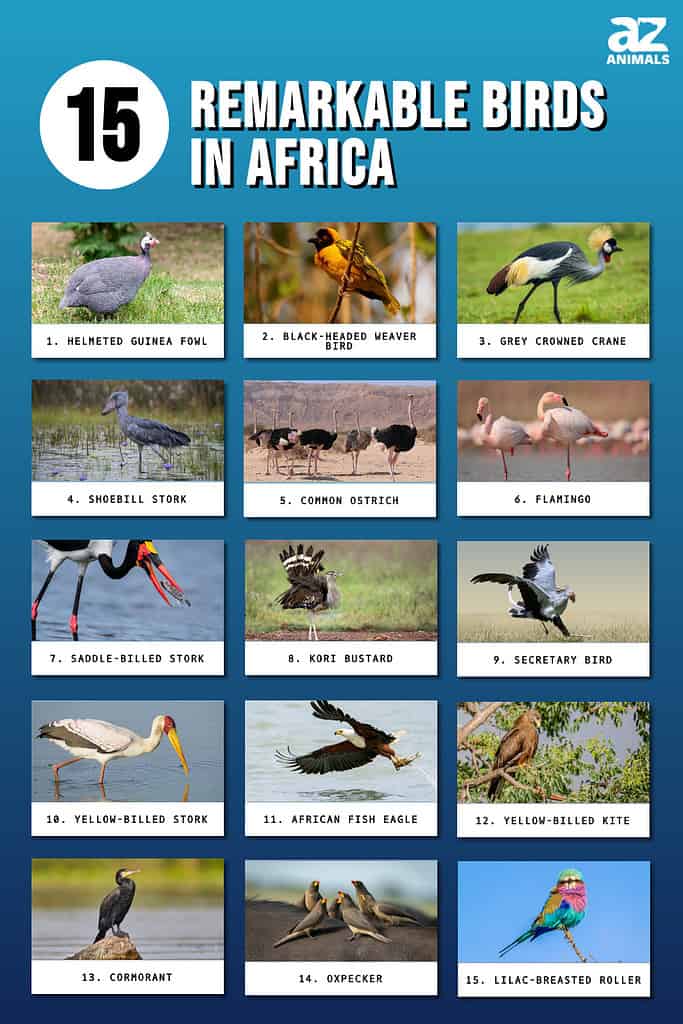
1. Helmeted Guinea Fowl
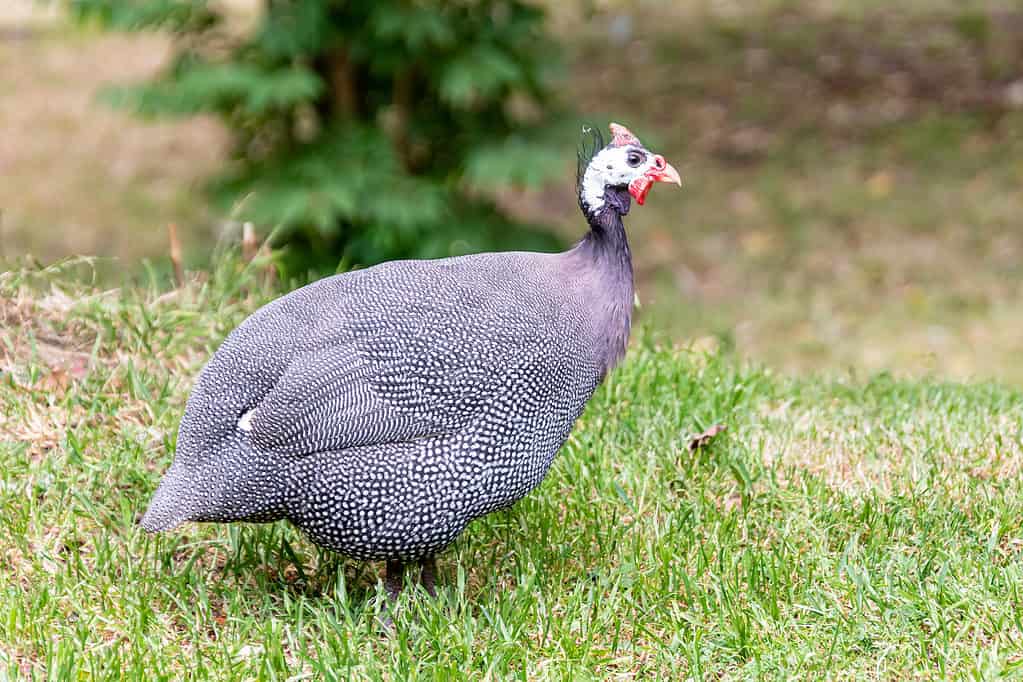
Guinea hens were historically coveted for their meat, eggs, and feathers as far back as the Roman era.
©Merrillie Redden/Shutterstock.com
Approximately the size of a chicken, the helmeted guinea fowl (Numida meleagris) is an earth-dwelling African bird with a head that doesn’t contain any feathers! It has a rotund body covered in patchy white and black feathers. They are gregarious birds that gather in big flocks and frequently follow groups of larger mammals, such as zebras, impalas, and monkeys, in search of food, such as bugs and seeds.
Additionally, they are essential in maintaining control over flies, fleas, and locusts. There are nine recognized subspecies of this bird, all of which may be found in sub-Saharan Africa in mostly open environments like meadows and woodlands, where they are easy to spot.
They may be rather noisy when in groups and entertaining to watch as they frantically scramble around. Guinea hens were coveted for their meat, eggs, and feathers as long back as the Roman era. They are now both raised as domestic animals and hunted for food.
2. Black-Headed Weaver Bird

There are about 60 different types of weaver birds, the majority of which are found in sub-Saharan Africa.
©Martin Mecnarowski/Shutterstock.com
The Ploceidae family of weaver birds is renowned for their amazing nest-building abilities. The male weaver bird constructs a complex nest out of grasses, petals, and twigs in an effort to entice a mate in the hopes that a female will find it attractive. The females only go to the males that can build the nicest nests.
Keep an eye out for weaver birds at riverbanks and lakeshores as they frequently construct their nests close to water, where they will be more difficult for predators to access. There are about 60 different types of weaver birds, the majority of which are found in sub-Saharan Africa.
A few species are also found in Australia and tropical Asia. Although they vary in hues from mottled brown and black to bright red to yellow, all of these birds have short, conical beaks that are ideal for feeding and building nests.
3. Grey Crowned Crane
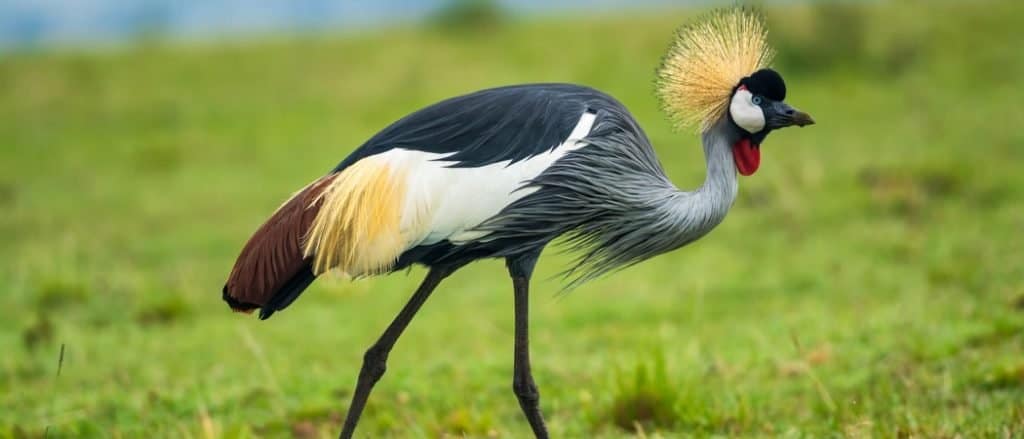
The grey crowned crane, which is Uganda’s national bird, is at risk of extinction.
©iStock.com/Nick Fox
Tanzania, Kenya, and South Africa are just a few of the countries in Eastern and Southern Africa where you can see the grey crowned crane (Balearica regulorum). Additionally, it serves as Uganda’s national bird and is depicted in the center of the nation’s flag.
Also known as the crested crane, the grey crowned crane grows to a height of around 3 feet and has a wingspan of nearly 7 feet. The vivid red neck pouch, white face, blue eyes, and striking gold feather crown make it one of the easiest African birds to identify. It is one of just two types of cranes that can roost in trees.
Grey crowned cranes perform a complex courtship dance that includes bowing, bouncing, expanding their wings, and hopping. However, they don’t only perform this in the mating season; you might see this performance at any point in the year, so be prepared with your camera!
Because of local degradation and harassment by certain farmers who view them as a nuisance, grey crowned cranes are at risk of extinction.
4. Shoebill Stork

The shoebill stork, also known as the whalehead or shoe-billed stork, is very large and grows up to 5 feet tall.
©Petr Simon/Shutterstock.com
The shoebill stork (Balaeniceps rex) is fascinating due to its resemblance to dinosaurs, which this species evolved from. Only 5,000 to 8,000 of these incredible birds remain in Africa. They can be found in freshwater marshes in countries including Uganda, Rwanda, South Sudan, western Tanzania, and northern Zambia in central and eastern Africa.
The shoebill, often known as the shoebill stork, is a solitary bird that inhabits marshy swampy areas where it can remain still for extended periods of time while hunting for fish, amphibians, and water snakes.
The shoebill is enormous, standing up to 5 feet tall with a nearly 26-foot wingspan. Its large bill, which some have compared to a shoe and may reach 1 foot long and 9 inches wide, gave rise to its moniker. Although they are primarily silent, they use this enormous bill to interact with other birds by making loud, frightful, clattering noises.
5. Common Ostrich
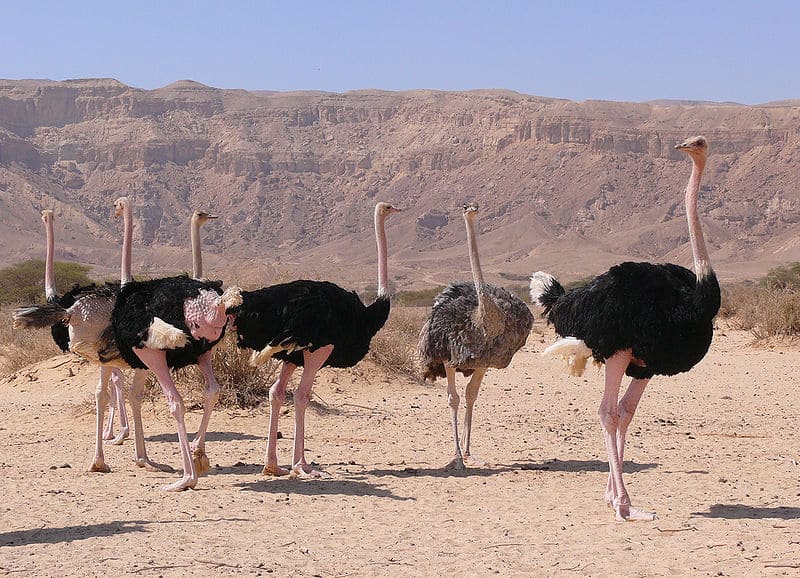
The ostrich is the fastest bird or mammal on two legs and can run at speeds of over 40 miles an hour.
The common ostrich (Struthio camelus) is widespread throughout Africa, from East and Southern Africa to North Africa, including Tunisia, Egypt, and Morocco. Because of their size, they favor grasslands and savanna regions like the Serengeti and Maasai Mara, where they are extremely easy to find. If you want to get up close to these birds, you can tour ostrich farms in South Africa.
The ostrich is currently the largest bird alive and the fastest bird or mammal on two legs. Although far too large to fly, it can run at over 40 miles an hour and cover up to 17 feet in one stride. Their lengthy legs have the ability to kick a human or a potential predator like a lion to death. They produce giant eggs that are comparable to two dozen hens’ eggs in size and are the biggest of any existing bird.
Ostriches can be spotted in the winter in couples or alone. However, during the breeding season, they gather in groups containing one male in charge of a harem of a maximum of seven females.
6. Flamingo

Flamingos can be found in Africa at designated breeding sites near salty lakes.
©Ondrej Prosicky/Shutterstock.com
You’ll have to make a special visit to view these magnificent African birds because flamingo populations tend to be concentrated at designated breeding sites near salty lakes. But if you can make it to one of these locations, you’ll be greeted with the breathtaking sight of a large group of flamingos known as a flamboyance.
Flamingos belong to the family Phoenicopteridae. Two of the six flamingo species — the larger and smaller flamingos — are found throughout Africa. Breeding habitats include the Tanzanian Lake Natron, the Kenyan Lakes Nakuru, Bogoria, Elmenteita, and the South African Kamfers Dam.
When feeding, flamingos scrape up muck from the lakebed and filter out minute crustaceans and plankton with their uniquely equipped bills. They are pink because the little shellfish they consume are pink.
7. Saddle-Billed Stork

The saddle-billed stork’s colorful beak has brilliant red stripes and a bright yellow frontal shield, or “saddle.”
©Matrishva Vyas/Shutterstock.com
The saddle-billed stork (Ephippiorhynchus senegalensis) is another intriguing-looking bird you might encounter on your African expedition. This stork is the tallest stork in the world, reaching nearly 5 feet high and taller than the gigantic marabou but not as hefty.
Its colorful beak, which has brilliant red stripes and a bright yellow frontal shield, or “saddle,” gives this bird its name. Additionally, you’ll see that it has a peculiar red and yellow spot on its breast. This is called the “brood patch,” a region of exposed skin that is densely populated with blood capillaries and is used during mating season to make sure that body heat can be passed between the mother and the egg with ease.
These birds live alone or in pairs, in contrast to marabou storks, which establish colonies. They can be found all over sub-Saharan Africa, especially in Gambia, Senegal, and Chad in the west and Kenya, Tanzania, and Uganda in the east. They can also be found in South Africa, where these birds are thought to be endangered.
8. Kori Bustard
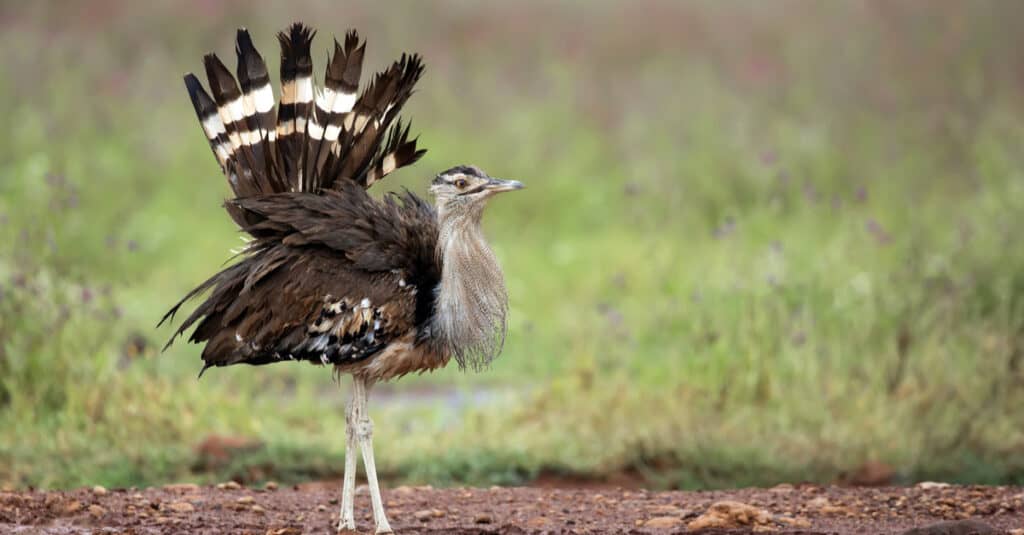
The main colors of the Kori bustard are brown with grey with fine black and white patterns.
©zahorec/Shutterstock.com
The Kori bustard (Ardeotis kori), one of Africa’s biggest and heaviest flying birds, spends much of its time sitting on the ground. It only flies to avoid predators and lands as quickly as possible. They are significantly different from the nimble flamingo in that they can grow to a height of 3 feet. It is said that male kori bustards are the heaviest flying birds in the world at a weight of up to 40 pounds.
These birds can be found throughout eastern and southern Africa, particularly in Botswana, Namibia, and Tanzania. They frequently accompany herds of zebras or antelopes in search of critters that have been startled by their hooves. They are primarily found in open grasslands and savannas.
They occasionally appear to have a “dust bath” because, unlike other African birds, they lack a preening gland that secretes oil to keep their feathers free of parasites. The meat of kori bustards is hunted in several regions of Africa.
9. Secretary Bird
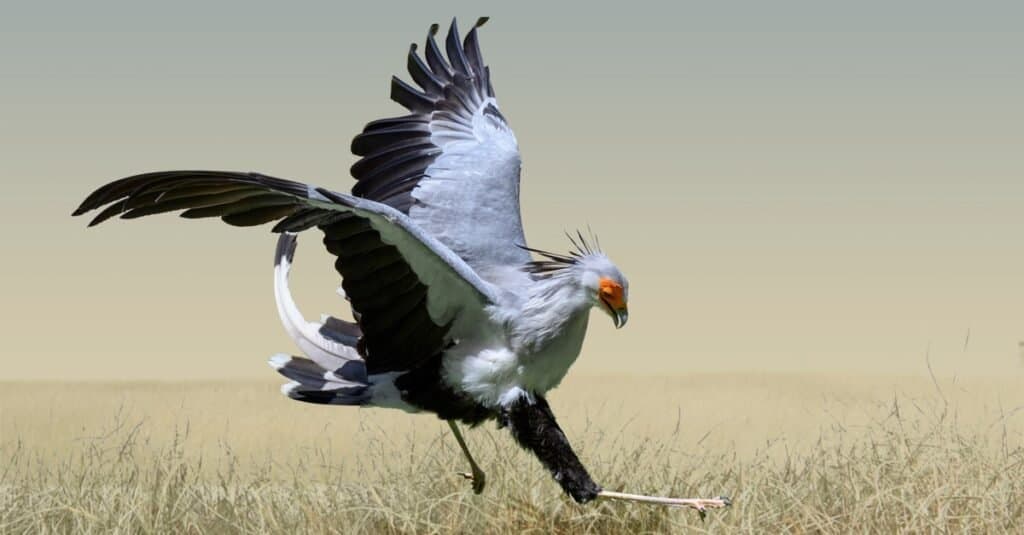
The secretary bird can deliver precise and powerful kicks with a force five times its own body weight.
©Barbara Ash/Shutterstock.com
One of the African birds with the most striking appearances is the secretary bird (Sagittarius serpentarius). This largely ground-dwelling bird of prey, which is almost 4 feet tall, is easily identified by its long pink legs, naked red face, and pointed, curved yellow beak.
The name is believed to have originated from the belief that this bird somewhat resembles a 19th-century clerk or secretary. Take a look at what appears to be knee-length black pants. They also have a dark coat, and the feathers on their head resemble quills!
The secretary bird is most frequently seen in the broad plains and brush of the sub-Saharan region, from Somalia and southward to South Africa.
The secretary bird is one of only two species of raptors (the other is the South American caracara) that forage on the ground rather than from the air. They are well known for stomping their victims to death with their muscular feet and keen claws while feeding on tiny rodents, frogs, and reptiles. U.K. scientists have found this bird is capable of delivering kicks with a force five times its own body weight that are enough to kill venomous snakes in the blink of an eye.
10. Yellow-Billed Stork

Yellow-billed storks are often seen around wetland areas and lakes in eastern and southern Africa.
©Stu Porter/Shutterstock.com
Medium-sized wading storks called yellow-billed storks (Mycteria ibis) inhabit marshes and rivers where they feed mostly on small aquatic species such as crabs and toads, as well as insects.
These birds are intelligent and adaptable when it comes to hunting methods. They agitate the riverbed with one foot while hunting to flush out any prospective prey from their hiding spot. When the animal starts to move, the stork’s quick reflexes allow it to quickly take it out of the water.
Yellow-billed storks are most frequently seen around wetland areas and lakes in eastern and southern Africa, from Senegal to South Africa, as well as some areas of Madagascar.
11. African Fish Eagle
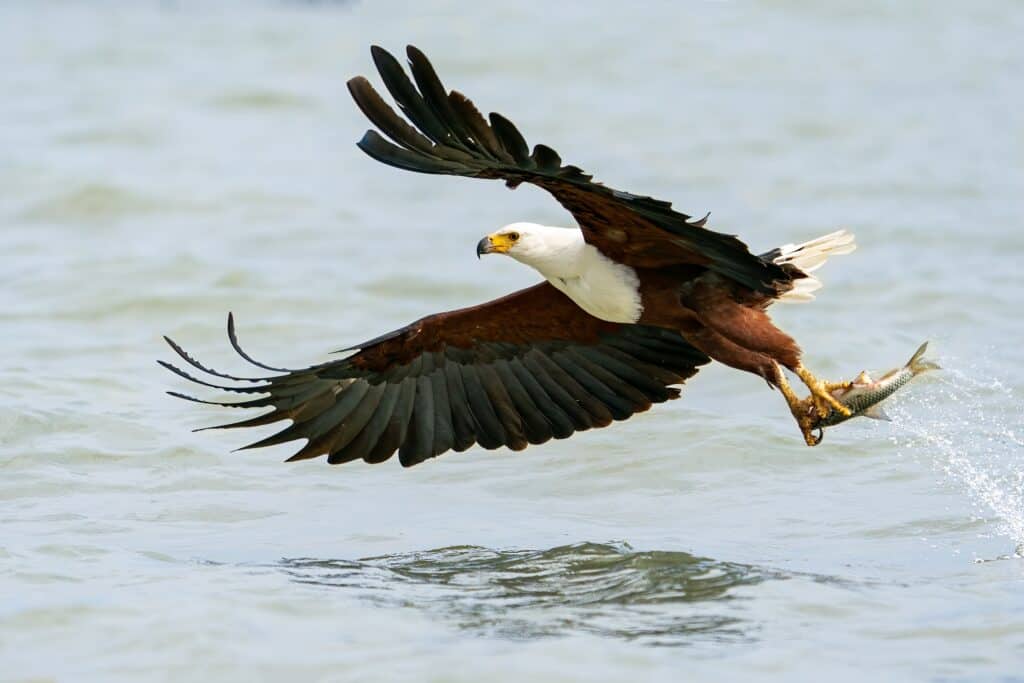
African fish eagles have rough soles and pointed spikes on their toes so fish don’t slip out of their talons.
©Tomas Drahos/Shutterstock.com
With a wingspan that may measure up to a whopping 8 feet, the African fish eagle (Haliaeetus vocifer) is one of the most recognizable of all African birds of prey. It is also one of the largest African eagles.
One of the “sounds of Africa” is thought to be its characteristic shrieking call. It mostly consumes fish, as suggested by its name, and possesses pointed spikes on its toes to assist it in grasping its slick prey.
The African fish eagle has a vast range and may be found all over sub-Saharan Africa. It is the national bird of Namibia and Zambia. Since fish is the majority of its diet, it is frequently seen sitting conspicuously close to lakes and rivers. They can be spotted near Lake Victoria.
The majority of the 60 eagle species inhabit Europe and Africa. They are enormous, robust raptors with eight times greater eyesight than humans’, allowing them to see even minute prey from more than a mile away.
12. Yellow-Billed Kite
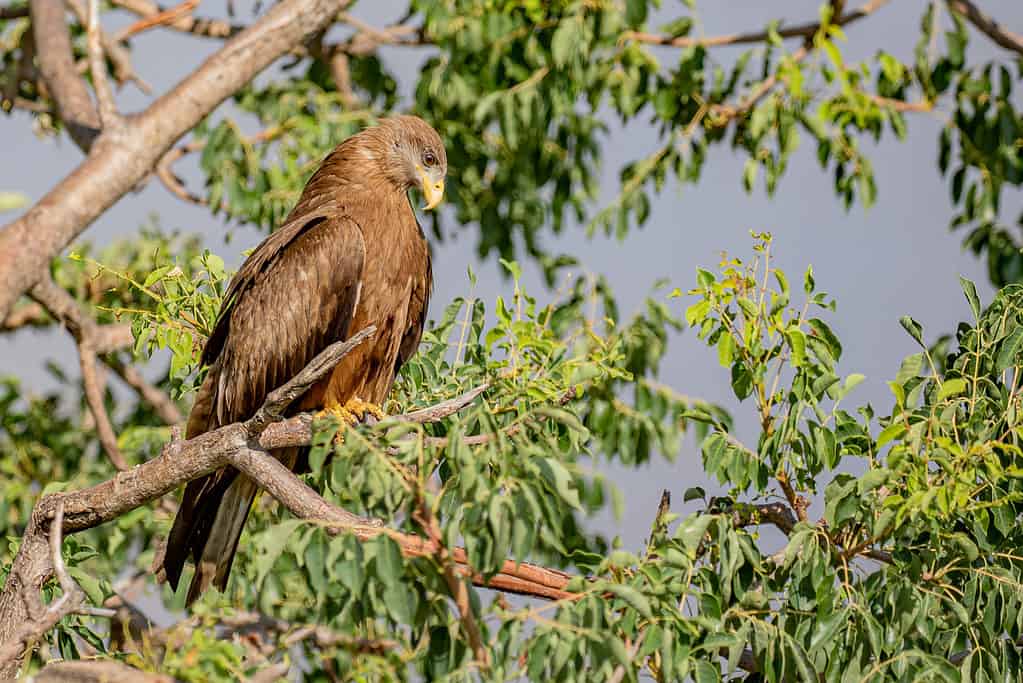
Kites are swift and speedy flyers with the ability to accelerate suddenly.
©Morne Grobler/Shutterstock.com
Due to its vivid yellow beak, feet, and V-shaped tail, the yellow-billed kite (Milvus aegyptius), a moderate-sized bird of prey, can be easily identified. These creatures can reach a height of 22 inches and have a 5-foot wingspan.
Kites are swift and speedy flyers with the ability to accelerate suddenly. They can also catch and devour insects while in flight. They are aggressive towards people and scavengers as well, occasionally even taking food from picnic benches or other animals.
Yellow-billed kites are not thought to be in danger and are found all over sub-Saharan Africa in practically every type of habitat, including cities.
13. Cormorant
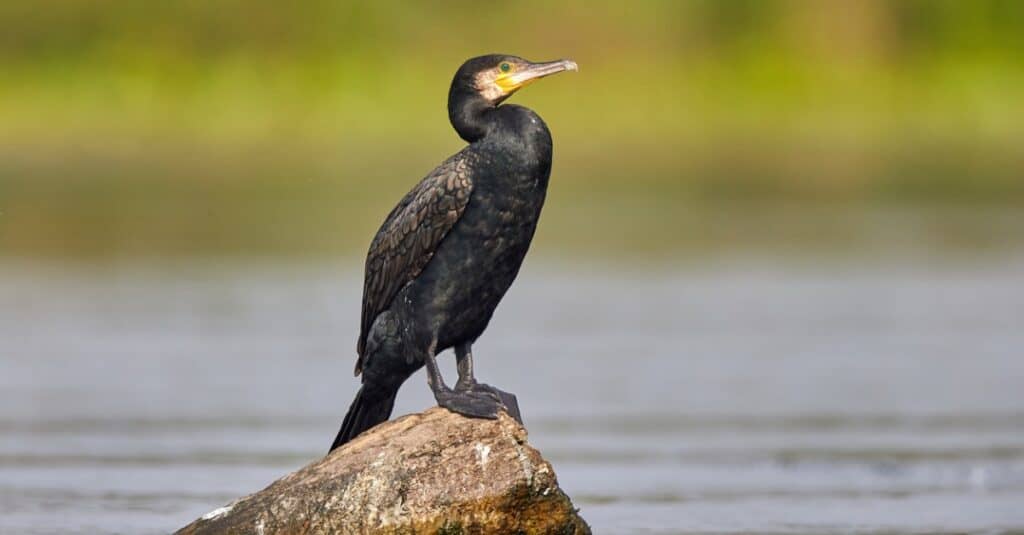
Cormorants plunge underwater to capture fish and swim using their wings as fins.
©iStock.com/Richard Constantinoff
Another widespread African waterbird is the cormorant, which can be seen along rivers, lagoons, and ports. Cormorants of various kinds belonging to the Phalacrocoracidae family, including the crowned, long-tailed, and Cape cormorant, can be found throughout Africa.
The most prevalent bird in sub-Saharan Africa is the great cormorant (Phalacrocorax carbo). It is a white-breasted freshwater-only species easily sighted near bodies of water around the entire continent from east to west and can even be spotted in South Africa.
Cormorants plunge underwater to capture fish and swim using their wings as fins. Their plumage is not waterproof, which is unexpected for a bird of the sea. These birds frequently linger with their wings wide, drying them in the sun as a result. After eating, they are said to turn toward the sun because the warmth helps them digest the cold food.
14. Oxpecker

Pesticides meant to eliminate parasites from livestock are often deadly to oxpeckers.
©Nwdph/Shutterstock.com
If you go on a jeep safari or safari in Africa, you will certainly see the oxpecker, another interesting African bird. Red-billed (Buphagus erythrorhynchus) and yellow-billed (Buphagus africanus) oxpeckers are the two different species, and both coexist peacefully with large mammals such as buffalo, elephants, and zebras while eating any flies and ticks that feed on the blood of these creatures.
The savannas of sub-Saharan Africa are home to many oxpecker species. There will very certainly be an oxpecker sitting on the back of a cattle, rhinoceros, or other huge creatures in Ethiopia, Somalia, Kenya, and Tanzania, among other countries. So keep an eye out for them!
15. Lilac-Breasted Roller
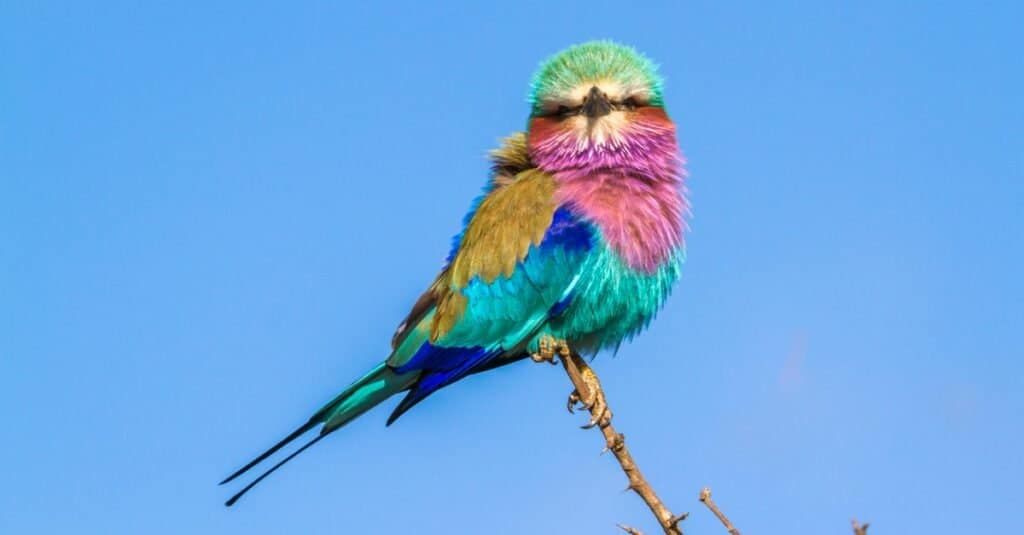
Lilac-breasted rollers build their nests in very high places.
©iStock.com/Utopia_88
One of the most beautiful and colorful African birds is the lilac-breasted roller (Coracias caudatus). It belongs to the roller family, so named because of the incredible aerial gymnastics they can perform.
The lilac-breasted roller is very protective of its nest and will actively defend it, even going up against much larger birds. The males fly high during the breeding season before plunging and swooping down while emitting loud sounds to entice ladies.
These birds can be found in eastern and southern Africa. They can frequently be seen sitting alone as well in pairs on a tree, scanning the air for bugs and beetles, with their distinctively colorful plumage glistening in the sunlight. They are found in open forests and bushy savannas.
Summary of 15 Remarkable Birds in Africa
Here’s a recap of the 15 amazing birds we looked at that can be found in Africa.
| Number | Bird Species | Scientific Classification | Habitat / Range |
|---|---|---|---|
| 1 | Helmeted Guinea Fowl | Numida meleagris | Meadows and woodlands in sub-Saharan Africa |
| 2 | Black-Headed Weaver Bird | Ploceidae family | Riverbanks and lakeshores in sub-Saharan Africa |
| 3 | Grey-Crowned Crane | Balearica regulorum | Eastern and Southern Africa |
| 4 | Shoebill Stork | Balaeniceps rex | Freshwater marshes in central and eastern Africa |
| 5 | Common Ostrich | Struthio camelus | Grasslands and savanna in east and southern Africa to North Africa |
| 6 | Flamingo | Phoenicopteridae family | Throughout Africa |
| 7 | Saddle-Billed Stork | Ephippiorhynchus senegalensis | Across sub-Saharan Africa |
| 8 | Kori Bustard | Ardeotis kori | Open grasslands and savannas in eastern and southern Africa |
| 9 | Secretary Bird | Sagittarius serpentarius | Broad plains and brush of sub-Saharan Africa |
| 10 | Yellow-Billed Stork | Mycteria ibis | Marshes, rivers, lakes and wetland areas in eastern and southern Africa |
| 11 | African Fish Eagle | Haliaeetus vocifer | All over sub-Saharan Africa |
| 12 | Yellow-Billed Kite | Milvus aegyptius | Across sub-Saharan Africa, including cities |
| 13 | Cormorant | Phalacrocoracidae family | Throughout Africa |
| 14 | Oxpecker | Buphagidae family | Savannas of sub-Saharan Africa |
| 15 | Lilac-Breasted Roller | Coracias caudatus | Open forests and bushy savannas of eastern and southern Africa |
The photo featured at the top of this post is © Tomas Drahos/Shutterstock.com
Thank you for reading! Have some feedback for us? Contact the AZ Animals editorial team.






